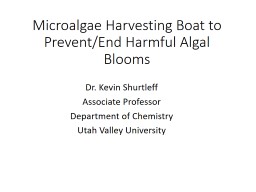

PreventEnd Harmful Algal Blooms Dr Kevin Shurtleff Associate Professor Department of Chemistry Utah Valley University Global Problem Harmful Algal Blooms HABs Red Tide Florida Coast August 2018 ID: 1036285
Download Presentation The PPT/PDF document "Microalgae Harvesting Boat to" is the property of its rightful owner. Permission is granted to download and print the materials on this web site for personal, non-commercial use only, and to display it on your personal computer provided you do not modify the materials and that you retain all copyright notices contained in the materials. By downloading content from our website, you accept the terms of this agreement.
1. Microalgae Harvesting Boat to Prevent/End Harmful Algal BloomsDr. Kevin ShurtleffAssociate ProfessorDepartment of ChemistryUtah Valley University
2. Global Problem: Harmful Algal Blooms (HABs)Red Tide, Florida Coast, August 2018.Microalgae -Dinoflagellate species.Warm water and nutrients stimulate growth.Can double in less than 24 hoursRelease toxins harmful to fish and humans.Consume oxygen, killing fish.
3. Global Problem: Harmful Algal Blooms (HABs)Cape Coral, Florida Coast, August 2018
4. Local Problem: Harmful Algal Blooms (HABs)Utah Lake, July 2016.Microalgae - Blue green algae –cyanobacteria species.Warm water and nutrients stimulate growth.Can double in mass in less than 24 hours.Release toxins harmful to fish and humans.Consume oxygen, killing fish.
5. Climate – Past and PresentRoyal Tyrell Dinosaur Museum – Drumheller, Alberta, CanadaAt the end of the Triassic and the beginning of the Jurassic (208 million years ago), the climatological conditions of the Earth were much different.Alberta, Canada was tropical and able to support dinosaursCarbon dioxide concentration in the atmosphere was 2500-3000 ppmToday, the carbon dioxide concentration in the atmosphere is approaching 400 ppm. Where did the CO2 go?The carbon dioxide was captured by ancient cyanobacteria (algal blooms) and became the fossil fuels we are using today.
6. What Are Microalgae?Water plantsMany species and strainsTypically photosyntheticTypically unicellular(single cell organism)Very small3-6 micron diameter.Difficult to remove from water.Dominated by cyanobacteria that produce endotoxins
7. Photosynthesis106 CO2 + 16NO3- + HPO42- + 188H2O --sunlight ----> carbon dioxide nitrogen phosphorus waterC106H263O110N16P*50H2O + 146O2algae oxygenMicroalgae are photosyntheticThey consume lots of carbon dioxide, some nitrogen, and a little phosphorus to grow and multiply.1000 g of extracted algae removes from the water and air …50 g of nitrogen 7 g of phosphorus1,047 g of carbon dioxideGrowth rate doubles for every 10 C increase in temperature.Warming climate is increasing the extent of algal blooms.
8. HAB Growth Model – Utah Lake 2016Logistic model of population growthN(t) = K*N0exp(rt)/(K+N0(exp(rt) - 1)N(t) = population at time t = 3 days.No = initial population (t = 0) = 20,000 cells/ml K = localized carrying capacity = 20 million cells/mlR = Malthusian factor = 0.138
9. Option to End Harmful Algal BloomsKill the microalgae with biocide or pesticide.Death releases endotoxins, potentially increasing harm.Decomposition consumes oxygen, producing harmful anoxic water.Decomposition releases nutrients back into the water for future blooms.Biocide/pesticide may kill other, non-targeted, species.
10. Option to Prevent Harmful Algal BloomsWasterwater treatment upgrades to prevent nutrient addition.Does NOT solve current HABs.Does not reduce existing water nutrients.Impossible to control agricultural runoff.Very expensive to implement on existing wastewater treatment facilities.
11. Best Option to Prevent/End HABs: Microalgae HarvestingDirect water filtration using a floating water treatment system.Permanently removes microalgae.Reduces nutrient load in water.Discharges cleaner, clearer water.Patent pending designs and proprietary processes
12. Microalgae Harvesting ExperimentsTested six different microalgae harvesting technologies in the labMicrobubble air flotation with microfiber belt collectionFlocculent saturated microfiber belt collectionElectrostatic separation with microfiber belt collectionDiatomaceous earth (DE) filtration with backwash collectionDiatomaceous earth (DE) with swept filter collectionPlate and Frame Filter Press with filter aid additionDE filtration with swept filter collection
13. Plate and Frame Filter PressAlgae/Cellulose Filter CakeCellulose Addition to Pump IntakePlate and Frame Filter Press in Operation
14. Selected Microalgae Harvesting SolutionBoat mounted industrial plate and frame filter press. (MWWatermark)Proven, large-scale, solid filtration technology.Proven removal of of algae with cellulose addition.Truckable, self-propelled boat to transport filter press to HABs.Low technical risk.
15. Direct Microalgae Harvesting BoatOne - 30 foot x 10 foot harvesting boat.1800 gpm water filtration.2 x 8 hour shifts, 16 hours/day.1.73 million gallons of water filtered each day.325 kilograms of dry algae removed each day975 kilograms of dry biofuel produced each day0.1 gram algae per liter microalgae concentration (1 million cells per milliliter).50% removal efficiency.26 miles per day at 1.6 mph
16. Filter Press Solids – Microalgae BiomassFilter press produces low water microalgae solids.Dried, solid, microalgae can be used as a carbon neutral fuel.Microalgae can be composted to produce a natural fertilizer
17. Clean Renewable Energy Generation by GasificationALL Power Labs, GEK ( Gasifier Experimenter’s Kit) Pallet Generator.Solar dried algae, phragmites, or other biomass fuel.Produces synthesis gas (H2, CO) from partial oxidation of biomass fuel.20 kW, modified Kubota ICE engine generator runs on synthesis gas.1 kg biomass = 1 kW-hr of electricity.$20,000 complete
18. Commercialization – Algae Removal ServicesOperational year (months) 6Capital Costs per Boat $251,000 truckable, self-propelled, boat, cab (30x12) $80,000 filter presses $100,000 generator $25,000 air compressor $6,000 pumps $10,000 miscellaneous $10,000 construction $20,000 boat payback (yrs) 5Cost per operational year $50,200 Operating Costs per Operational Year $573,360 Operators (2 - 8 hr shifts, 6 days/week, 26 weeks) $99,840 Management (2) $220,000 Fuel $49,920 Consumables $12,480 Overhead $191,120 Operational yearly costs (6 months) $623,560Cost per day per boat $3,997Kilogram algae removed (dry weight) per day per boat 589Cost per kg algae $7.99Fleet of algae harvesting boats and ships (coastal waters) working around the US and World year-round.
19. Team MembersJeff KellerJacob KingPhillip RichBrenden TrumanDr. Kevin ShurtleffBlake AllredAustin BettridgeTyler JohnsonPeter Madsen
20. SupportUndergraduate Research and Creative Works, Grant for Engaged Learning (GEL) grantCollege of Science, student Scholarly Activities Committee grants.
21. Questions?Dr. Kevin ShurtleffPS-212Office: 801-863-5499Direct: 801-360-9799Email: kshurtleff@uvu.eduThank You